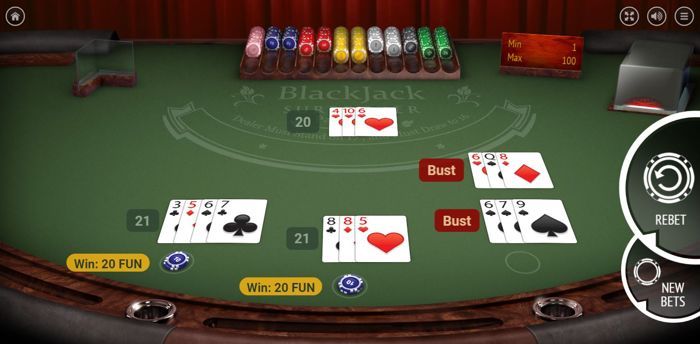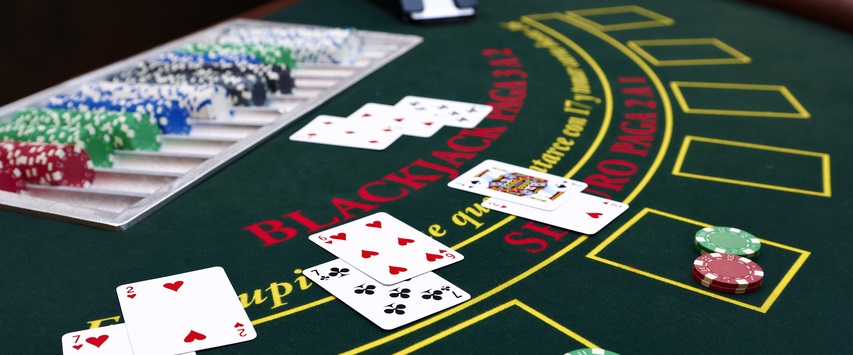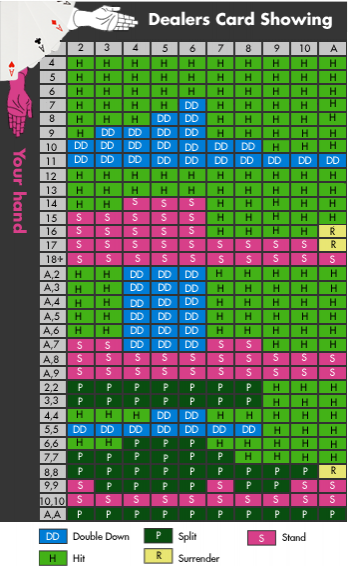Blackjack Surrender Hand Signal
Surrender, it's not like a lot of plays in blackjack where there are hand signals, and you've got hit and stay, and split double down, and all that. The hand signal for surrender is to make a little line right across the table, like that. But a lot of casinos in general would prefer a verbal. You need to surrender, if your hand is 15, the dealer's upcard is an Ace and your true count is +2 (in S17) or -1 (in H17). You need to surrender, if your hand is 14, the dealer's upcard is 10 and your true count is +4.

What is Surrender in Blackjack?
Simply put, it’s the option that allows you to fold your hand and receive half your bet back. So, instead of playing out a hand you don’t really fancy, you can simply surrender and let the casino take half of your bet. It goes without saying that this is an option only to be used if you receive a really rubbish starting hand.
Now blackjack surrender is not on offer at all casinos. Or even on all tables on the games floor. You’ll never see a sign for it either. This means that it’s up to you to ask the dealer if surrender is allowed. Another thing is that because many don’t realize such a thing can be played, you should prepare yourself for some funny looks from other players the moment you ask for this option. Not only are most players ignorant of this move, but those who do know of it, are equally ignorant in that they will automatically assume that it’s a bad move. Weirdly, some players appear to understand its purpose and yet, still shy away from using it. Like we said, just weird!
How do I Surrender?
If you want to surrender, then it needs to be the very first action after the deal. If you’ve already hit or doubled or split, then you can’t ask and you wouldn’t be allowed to surrender. Now there are normally two different hands used for this action. The most common is that you draw a horizontal line with your finger behind your bet. Think of the motion of “cutting your bet”. The other way is to hold your hands, palm upwards as if saying “I give up”. Keep in mind that neither of these hand signals is universal…so you still have to tell the dealer that you want to surrender. Or at the online jackpot sites, you just simply press the surrender button.
What is the difference between Early Surrender and Late Surrender?
The basic blackjack strategy offers three types of surrender: No Surrender, Early Surrender, and Late Surrender. Late surrender is by far the most common, and early surrender is quite difficult to find at all. So, if you’re unsure which one to choose, we suggest that you stick with late surrender. So…what’s the difference? Well, it’s all about what happens when the dealer has an Ace or Ten up card. If you surrender BEFORE the dealer checks for blackjack, then that’s called early surrender. This has value in that it allows you to get out of a possible dealer blackjack whilst losing only half your bet. late surrender is after the dealer has checked his cards for blackjack and didn’t have it. That’s the rule!
King Billy Casino Welcome Bonus
151% match bonus up to €500 + 51 Bonus Spins
This is an exclusive bonus. 18+. New customers only. Wagering requirement: 30×. Min deposit: €20. T&Cs Apply.Blackjack Surrender: What hands should I surrender?
So now you’re aware of what blackjack surrender is, we ask that you don’t overuse it. Remember that if you surrender a lot, you’ll be losing a lot of bankrolls as well. There’s also a mistaken belief that you should surrender any hand with a greater than 50% chance of losing. That’s a huge mistake. To make a correct surrender decision, your hand needs to be on a losing wicket more than 70% of the time. (Winning 25% of the time and losing 75% of the time means you’ll lose half you bet on average).
So, which initial hands should you surrender?
Blackjack Surrender Hand Signals
Here are the main ones:

Surrender hard 15 against a dealer Ten.
Surrender hard 16 against a dealer 9.
Surrender hard 16 against a dealer Ten.
Surrender hard 16 against a dealer Ace.
If you are playing a game where the dealer hits soft 17, add these surrenders as well:
Surrender hard 15 against a dealer Ace.
Surrender (8,8) against a dealer Ace.
Surrender hard 17 against a dealer Ace. (Yes, surrendering hard 17 against an Ace when the dealer hits soft 17s is the correct play.)
This particular advice is for six-deck games with late surrender. For specific advice tailored to your exact game, use the Strategy Engine, or purchase one of our Blackjack Basic Strategy Cards.
Blackjack Surrender: What’s it worth?
If you’re an effective player with basic strategy, then blackjack surrender can reduce the house edge by somewhere around 0.07% and 0.09%. This also depends on the other rules of the game. So if you’re a $10 better, you’d save around 50 cents per hour. OK, we are the first to admit this seems pretty piddly, but in blackjack, every little bit helps. Now for a card counter, surrender can be much more valuable, giving up to 0.7% or around 10 x larger. But you’ve first got to find a game that offers early surrender, which could take some time. We suggest that you talk with other players in order to find a casino with this action.
Remember that blackjack surrender is not a universal tool to dig yourself out of trouble. So, as we previously said, don’t go crazy with it. On the other hand, it is nice to know that you have the option should you ever want to take it.
Let’s face it, sometimes we are just having an off day, with bad hand after bad hand. And sometimes, surrendering is our best bet; an occasionally viable tactic in games of blackjack which allow the player to do so. Surrendering, as we explain in our glossary of blackjack terms, refers to the offer in some games styles of blackjack (mainly American versions) which allows players to forfeit their hand in the current round and get back half of their original wager. The option to do so is offered by some land-based casinos, and the majority of online casinos.
If you have a hard hand of 14 and the dealer has an Ace on show, surrendering in order to retrieve half of your bet instead of quite possibly losing it all can be appropriate. Surrendering is a feasible option if you are dealt a poor hand and the dealer has a strong hand, but it has to be used in the right situation. Otherwise, it’s money down the drain that could have won.
Available Surrendering Options

Surrendering is only available as a first decision of a two-card hand. It is usually only offered in hole-card games (but see below for variations), where the dealer draws two cards and may or may not peek at the hole (face down card), before players make their decisions. But in general, surrendering will usually only be available directly after the dealer has checked for blackjack.
The variations we speak of are early and late surrender. Late surrender, explained above, refers to being able to do so in hole card games, only after the dealer has checked for a blackjack. It is the most common option at all types of casinos. If the dealer checks and does indeed have a blackjack, surrendering is thus made unavailable.
Alternatively, early surrender is when you are allowed to surrender before the dealer checks (or if the dealer doesn’t check at all) for blackjack in hole-card games, or in a no-hole-card game, where the dealer does not draw a second card until all players have acted. As you can see, early surrender is significantly more favourable to the player than late surrender is, which is why early surrender is not often available.

When to Consider the Move
As mentioned above, surrendering can be an appropriate play if used at the right time. It may seem like a cowardly move which is not progressive or beneficial in the long-run, and it is if not used correctly: you’re wasting hands that have the potential to win. Only consider surrendering as a last possible resort on the very worst hands.
There are only a few hands in which surrendering can be considered (late surrender). If you are lucky enough to be playing with the rare early surrender option, this allows for more flexibility and you might consider surrendering medium to low strength hands if the dealer holds an Ace (and the hole-card has not yet been examined).
Poor Hands to Consider for Early Surrender
- You hold a total of 12 to 17 against a dealer’s Ace.
- You hold a total of five to seven against a dealer’s Ace.
- You hold a total of 14 to 16 and the dealer has a Ten.
- You hold a total of 16 and the dealer shows a Nine.
Blackjack Surrender Hand Signal
Poor Hands to Consider for Late Surrender
- Your hand totals a hard-15 and the dealer holds a 10-valued card or an Ace.
- Your hand totals a hard-16 and the dealer holds a Nine, 10-valued card or Ace.
- Your hand totals a hard-17 and the dealer holds an Ace.
How to Surrender in Blackjack
At most land-based casinos, BJ tables will have rules on a placard for players to view, but it is still worth confirming with the dealer before playing, just to make be certain surrendering (or any other option for that matter) is available. Online casinos will typically label each game with the available options which can be checked before, during and after play.
Surrender Hand Signal In Blackjack
To surrender at an online table, click the corresponding surrender button. To do so at a land-based BJ table, wait until you have the dealer’s attention after receiving your cards, and verbalise your intentions (with a possible follow-up hand signal). There is no standard hand signal for surrendering, but players will usually move a finger from right to left on the table above their cards (drawing an imaginary line). We suggest making your surrendering intentions clear by first saying so, because signalling a surrender with your hands can be sometimes be misinterpreted as a hit, so verbalisation is really the best way to go.
Once recognised, the dealer will remove your cards from the table, take half your bet and return the other half to you. Essentially, you have forfeited the opportunity to play out your hand and the casino keeps half of your bet while the other half acts as a push/stand-off/tie; whatever you want to call it.